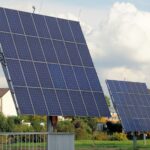Developed by scientists from the National University of Singapore (NUS), the Perovskites solar cells have achieved a remarkable world record efficiency of 24.35% with a cm2 active area.
Not only surpassing previous achievements, but also setting the stage for the commercialization of cheaper, more efficient, and more durable solar cells
Unleashing the Potential of Perovskite Solar Cells
Owing to their high light absorption efficiency and ease of fabrication, materials in Perovskites have gained attention in the solar energy field.
Perovskites solar cell technology has seen significant advancement over the past decade, and the NUS research team led by Assistant Professor Hou Yi has made notable strides in maximizing the efficiency of these cells.
The Journey to Record-Breaking Efficiency
Aimed at improving the efficiency of 1 cm2 perovskites solar cells, the NUS team embarked on a dedicated effort to develop innovative and scalable technologies.
They achieved a higher efficiency than conventional perovskites cells by incorporating an innovative charge-transporting material and utilizing an inverted-structure design.
The provision of enhanced stability and scalability by the inverted structure is a significant milestone in commercializing this cutting-edge technology.
Published Recognition and Future Prospects
The Solar Cell Efficiency Tables have included the achievements of the NUS team, proving their importance as a benchmarking reference for solar cell technologies.
The potential impact of their work and its contribution to the advancement of renewable energy solutions are highlighted by this recognition.
By moving forward, the team aims to further push the boundaries of perovskite solar cell technology.
Similar Post
Enhancing Performance and Durability
Improving the stability of perovskite solar cells is one of the key-focuses for future research, as these materials can degrade over time when exposed to moisture.
An aging methodology is being developed by the team to accelerate testing and ensure long-term operational stability.
The goal of the team is to deliver perovskite solar cells with a remarkable operational lifespan of 25 years.
Scaling Up for Wider Application
In order to facilitate the integration of perovskite solar cells into various energy systems, the team is working on scaling up the technology from individual cells to larger modules.
They aim to accelerate the process and drive the adoption of perovskite solar cells by expanding the dimensions of the cells and demonstrating their viability on a larger scale.
The Way Ahead
The NUS Research team’s ground breaking achievement in attaining a world record efficiency for perovskite solar cells opens up new possibilities for renewable energy generation.
These cells have the capacity to revolutionize the solar energy industry with their exceptional performance and potential for cost reduction.
The team is working towards a sustainable and renewable energy future, reducing our reliance on fossil fuels by addressing stability concerns and focusing on scalability.


















